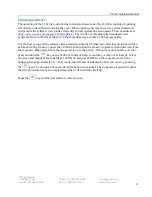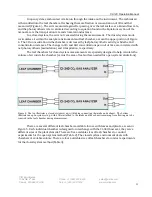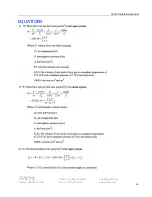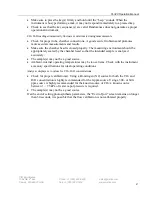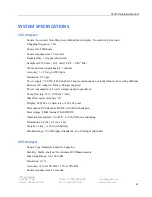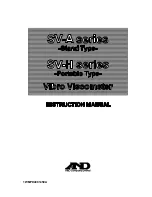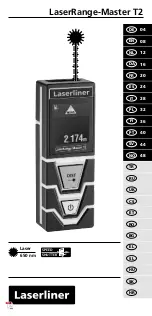
CI-340 Operation Manual
CID Bio-Science
1554 NE 3
rd
Ave
Camas, WA 98607, USA
Phone: +1 (360) 833-8835
Fax: +1 (360) 833-1914
sales@cid-inc.com
www.cid-inc.com
35
•
Calibration
is the comparison between measurements, one of known magnitude or
correctness, made or set with one device and another measurement made in as similar a way as
possible with a second device.
1
•
Traceability
is the unbroken chain of comparisons relating an instrument’s measurements to a
known standard. An instrument’s bias, precision and accuracy can be determined if an
instrument is calibrated to a traceable standard.
•
Precision
(or
reproducibility
or
repeatability
) is the degree to which repeated
measurements under unchanged conditions show the same results.
•
Accuracy
is the degree of closeness of measurements of a large quantity to its actual or true
value. In other words, accuracy is how many times the same measurement conditions produced
the exact same measurement over a large number of samples.
•
Bias
is non-random or directed effects caused by a factor or factors unrelated to the
independent variables.
•
Error
is the random variability, or the amount of deviation from a standard or specification. It
is also important to consider error when calibrating.
•
Resolution
refers to the smallest change in a measured value that the instrument can detect, or
the ability of the instrument to read in fine increments (small increases or decreases in possible
values of measurements).
•
Reliability
of measurements is sought after calibrating the instrument. Reliable measurements
are accurate and repeatable, as well as traceable.
The CI-340 has been engineered to ensure maximum reliability as well as ease of instrument
use in the field. The resolution of infrared gas analyzers is directly related to the length of the infrared
gas analyzer chamber. The longer the tube to the chamber is, the finer the resolution. In order to help
the CI-340 produce repeatable measurements, a single IRGA tube next to the leaf chamber is used to
measure CO
2
levels in the air before and after the leaf chamber. This increases repeatability because
with only one infrared sensor and a single light source, drift of the electronic components in the
machine is reduced (versus having multiple sensors and light sources which would all drift
independently of each other). Also, drift on humidity sensors has been reduced, providing high
repeatability in water content measurements by using laser trimmed humidity sensors.
There are five calibrations that can be done to increase the reliability and repeatability of the
CI-340. These include resetting the calendar and time of the instrument, recalibrating the leaf/air
temperature sensor (done only at CID), resetting the atmospheric pressure (done by user),
recalibrating the flow rate (done by user with flow meter), and recalibrating the CO
2
and H
2
O
concentration settings (done by user with gases of known concentrations). Please refer to later sections
for detailed instructions on how to calibrate the CI-340.
1
The device with the known or assigned correctness is known as the standard, while the second device is the unit under
test or test instrument. Typically standards with which calibrations are set on come from several national and
international standards organizations, such as the International Organization for Standardization (ISO), International
Calibration Standards (ICS), National Institute of Standards and Technology (NIST) and the American National
Standards Institute (ANSI).
Summary of Contents for CI-340
Page 3: ......

